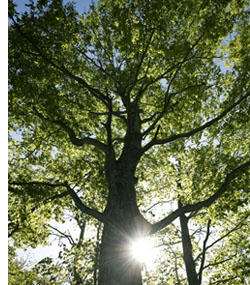Clearances Between Power Lines and Trees
Electric service reliability and public safety require clearance between trees and transmission lines in the right-of-way, be maintained at all times.
- Electric Reliability Standard FAC-003-4 requires that trees and other vegetation growing in or adjacent to the power line right-of-way be trimmed to prevent power outages caused by tree contact with a transmission line. Any power line contact with a tree can cause a short circuit which may lead to a blackout or threaten public safety.
- Trees and other vegetation are regularly pruned beyond the minimum clearance distance to account for the fact that they continuously grow and sway with the wind. Power lines can also sag due to high usage, heat, or snow/ice build-up. Thus prudent right-of-way maintenance necessitates a greater clearance distance between power lines and trees than may occasionally appear to be necessary.
- Each utility develops and implements its own tree trimming or vegetation management plan. Each plan must conform to requirements of state or local authorities and any applicable right-of-way or easement agreement with the property owner.
Why Tree Trimming is Necessary
Tree contact with transmission lines is a leading cause of electric power outages and a common cause of past regional blackouts, including the August 2003 blackout that affected 50 million people in the Northeast United States and Canada. Following the 2003 blackout and subsequent federal legislation, the Commission designated the North American Electric Reliability Corporation (NERC) as the Electric Reliability Organization (ERO), with the responsibility to develop and enforce standards to ensure the reliability of the Bulk Power System, including the Reliability Standard that addresses vegetation management covering tree trimming on rights-of-way, FAC-003-4.
Not All Power Lines Are Subject to NERC National Reliability Standards
The nation's electric system is divided into two different domains for regulatory purposes, largely based on the voltage of the facilities: high voltage transmission lines and lower voltage distribution lines.
- High voltage transmission lines operated above 200,000 volts (200 kV) and some transmission lines between 100 kV-200 kV are subject to Reliability Standard FAC-003-4. These transmission lines are typically those on high steel towers or very large wooden structures with multiple lines.
- Lower voltage distribution lines, (generally those lines below 100 kV) are controlled by the utility regulatory commissions within each state. These are typically the lines running in residential neighborhoods on wooden or metal poles, and usually operated at voltages between 4 kV and 36 kV.
- Most but not all tree trimming or vegetation management activities that directly affects homeowners involves local distribution, not transmission, and is, therefore, exclusively subject to state and local requirements and oversight (not Reliability Standard FAC-003-4).
Landowner Rights – Rights-of-Way Agreements
The rights of landowners with respect to trees and power lines are not established by the Commission or the Reliability Standards.
- Landowner rights are usually formalized in a utility right-of-way to the property, which may be attached to your property deed, describing the rights of the parties for building and maintaining electric lines.
- Right-of-way agreements are subject to the review of local regulatory authorities, and/or the local courts.
- You may contact the utility company that owns the transmission line to determine if it has the specific available records.
Commission Jurisdiction over Vegetation Management, including Tree Trimming
The Commission’s jurisdiction is over ensuring sufficient clearance between electric transmission lines and anything that might cause a flash-over (e.g., buildings and other structures, trees and other vegetation). Generally, transmission lines refer to those lines on large steel towers, not those on wooden poles in neighborhoods. The Commission, through Reliability Standard FAC-003-4, requires transmission owners to have a minimum clearance between transmission lines and trees, and it does not establish a maximum clearance or any particular method of managing vegetation (e.g., trimming vs. removing a tree) that a utility may choose to use. Because the Commission’s authority is limited to electric reliability and not safety, the Commission has no ability to assist landowners in the removal of trees.
Contact Us If You Are Unsure!
FERC receives many calls and emails from landowners related to tree trimming or utility vegetation management practices. While FERC has no direct responsibility over tree trimming or utility vegetation management practices, we encourage landowners to bring to our attention any scenario that they are unsure of so we can see if we can help (Tree Trimming & Vegetation Management Issues Form).
- This may include questions about how a transmission company actually conducts transmission vegetation management, including its vegetation management plan and whether its practices are required by the Commission (see FAQs: Tree Trimming and Vegetation Management Landowners).
- Questions about vegetation management for distribution lines are better answered by the local state regulatory commission or other local governmental authority (See State Commissions).
- If your local electric company cannot answer your question, another good source of information is the state regulatory commission, which usually has a customer complaint service.
Quick Links
- FAQs: Tree Trimming and Vegetation Management Landowners
- State Commissions
- Utility Vegetation Management Final Report
- Order No. 785
- 2003 Blackout Information
- NERC Information
- Regional Entity Information
- International Society of Arboriculture – Standards & Practices
- Trees are Good – Tree Care Information
- Utility Arborist Association
- FAC-003-4
- Order No. 777
- Northeast Transmission Outage Stresses Vegetation Management Presentation
- Northeast Transmission Outage Stresses Vegetation Management Report
- Chairman's Statement
Contact Information
-
Mark HegerleTelephone: 202-502-8287
-
Dennis Fuentes PedrosaTelephone: 202-502-6627
-
Email: [email protected]Email: [email protected]

